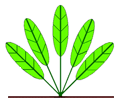


Riparian Tree Leaves dried
Riparian Tree Leaves dried
General information: The first three photos are places where riparian leaves have been photographed submerged in natural locations. One is shallow water in the Edith River, NT. Two is the bottom of Anniversary Creek, NT. Three is the edge of Stray Creek, NT. All these places have healthy shrimp populations. Photo four is dried leaves packed. The vegetation that grows next to lakes, rivers, creeks and billabongs is called riparian vegetation. The trees near waterways in the wet dry tropics drop leaves in the dry season. These leaves end up in the water and commence to decay, too many will deplete the dissolved oxygen levels from the bacterial action but in most waterways these leaves are an important source of nutrition for the aquatic life in the stream. They are the start of the food chain, the bacterial slime on the leaf is eaten by minute organisms such as shrimps and snails.
Cultivation notes : A few dry leaves from riparian trees such as Indain Beech, Paperbarks, Black Wattle, Leichardt Tree, freshwater mangroves, aquatic pandanus and others in an aquarium or pond give small creatures a place to hide and some nutrition. Too many leaves will deplete dissolved oxygen levels and may be detrimental. However a few leaves, perhaps 3 or 4 per ten litres of aquarium water will be beneficial. The other benefit from a few leaves is the tannins and other organic compounds that improve water quality thus making a more natural habitat for little critters. Shrimp keepers benefit the most from a few leaves with many of the small caridina larvae or juveniles benefiting from decaying leaves for food. Aquagreen has grown these trees on the block for many years but only in the last 5 years been using the leaves for shrimp production.
Distribution : Tropical riparian vegetation is along all water ways.
Selling details : Sold dried in a pack of 60 grams
Reference: Personal notes and photos